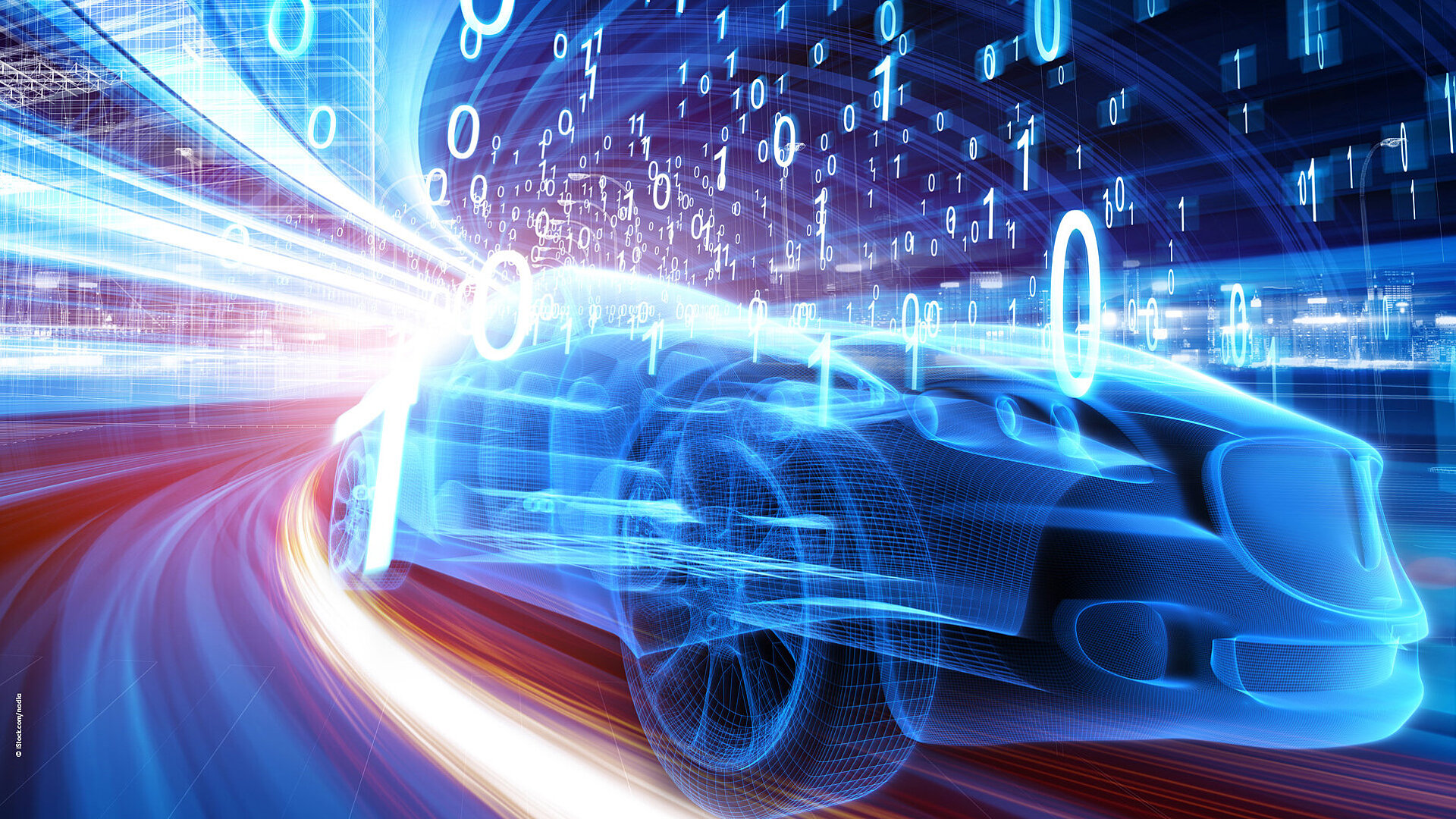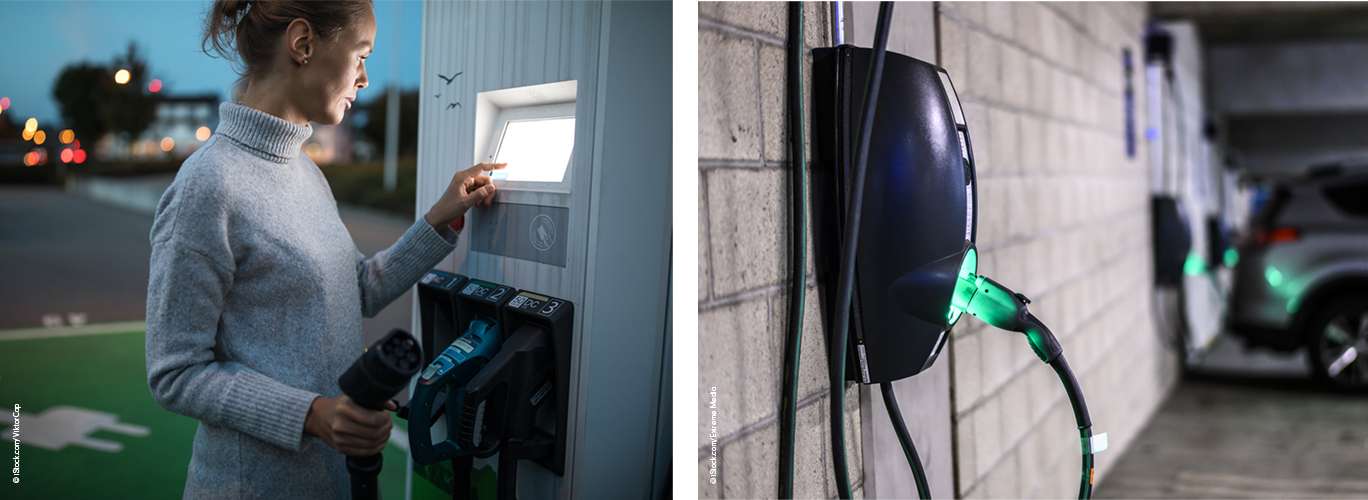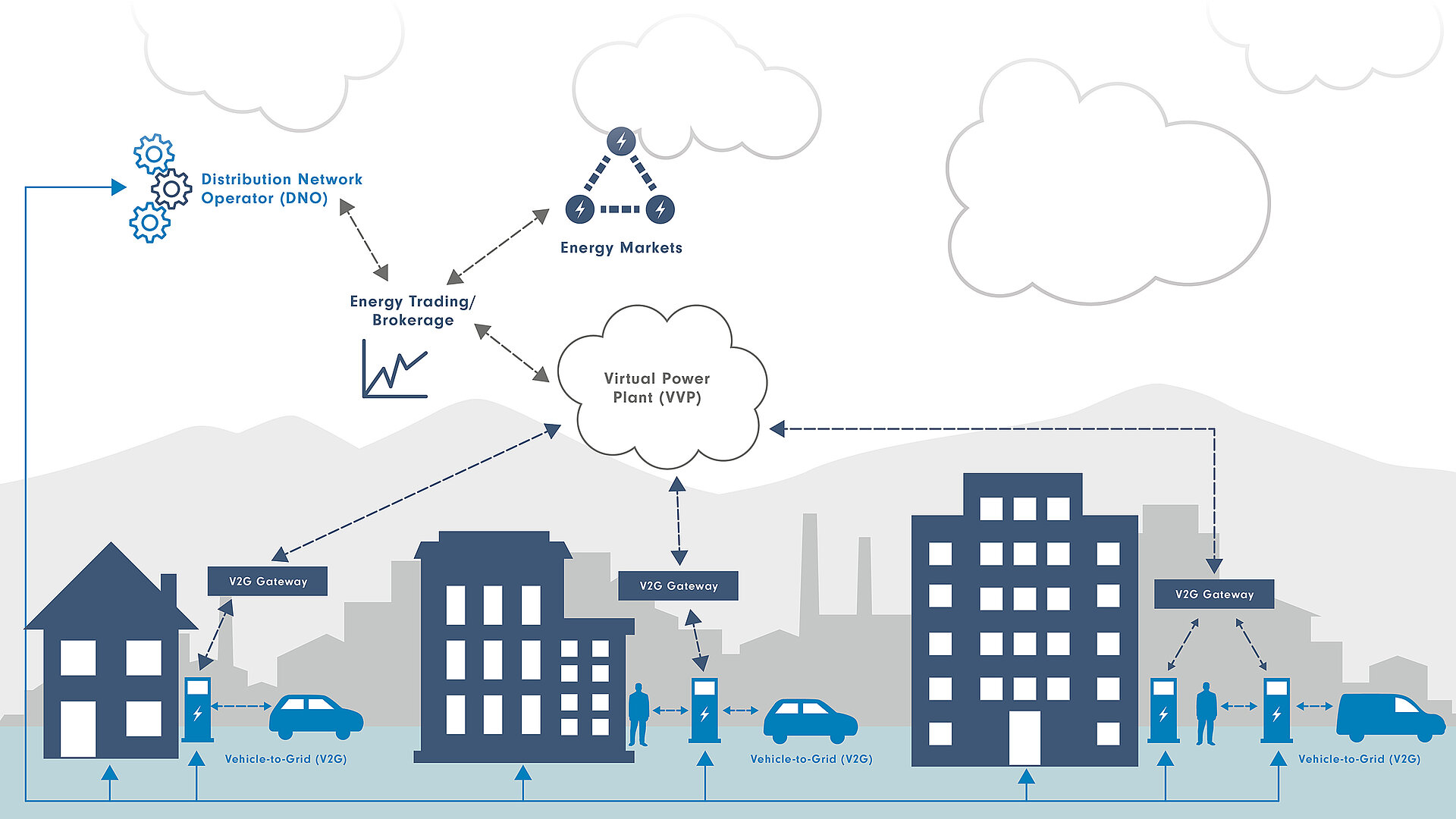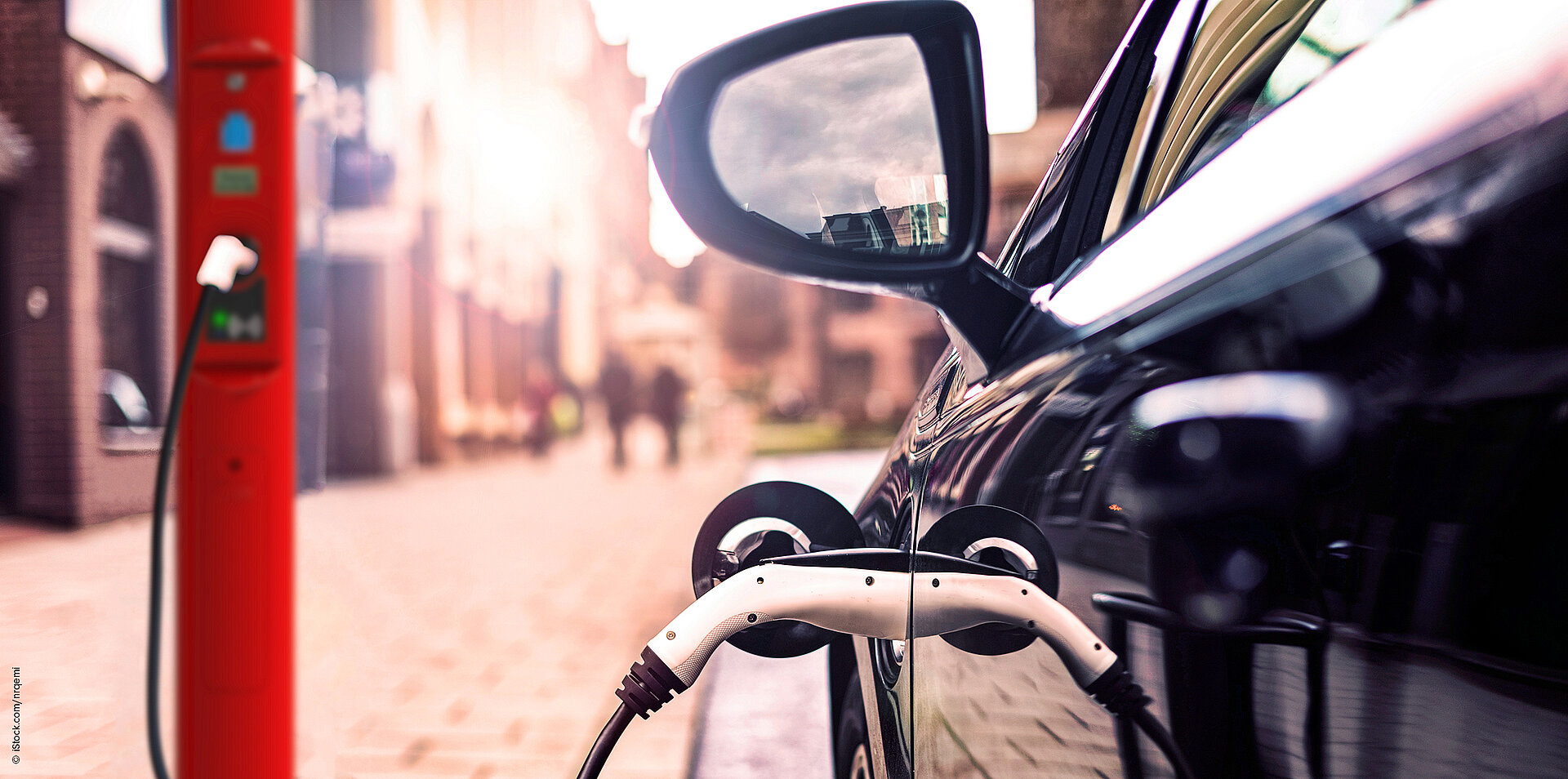The development is gaining momentum
E-mobility is one of the most advanced main instruments in advocating for the stricken planet, alongside renewable energy, organic farming, waste avoidance and the digitalisation of production and work, as well as an increasing virtualisation of public and private sectors.
Extensive or even complete electrification of transportation would lead to a significant reduction in emissions and would have other advantages, such as the intelligent networking of an infrastructure that would then be automatically adaptable and, last but not least, would enable intermodal vehicle usage, which offers a maximum degree of flexible individual mobility.
One thing is clear: Without a tremendous expansion of electric mobility, including the corresponding infrastructure, the climate targets (see info box below) issued by the federal government and necessary for the long-term preservation of our living space cannot be achieved.
In addition, with further expansion and densification of highly populated areas, the cities of the future are hardly conceivable without smart controlled traffic routes and electronically operated means of transport. And are also not desirable with regard to the quality of life of the residents. Smiled at just a few years ago, as a naive vision of those ambitious to save the world, e-mobility is now clearly taking off. In a study, the Boston Consulting Group (BCG) calculates that more electric cars (battery + hybrid) will be sold in 2030 than conventional vehicles with combustion engines. According to the BCG, the development is being fuelled by the regulation of exhaust emissions and falling battery costs. In the coming years alone, prices are expected to fall by a whopping 80 percent.
The government also continues to pursue ambitious plans: By 2030, those responsible envision 7-10 million electric cars and 500,000 electric trucks humming along the roads, supplied by 1 million charging points. These objectives now appear to be achievable. Because other economies are oriented towards the future as well: Not least, economic giant China is increasingly investing in the electrification of transport and is playing a pioneering role among the industrialized countries. Other countries are following suit. The „Electric Vehicle Index“ of the management consultancy McKinsey, has already identified Europe as the future hotspot of electric mobility.
Purchase costs and range are two important criteria for the success of e-mobility. There is also another important aspect: An appropriate infrastructure for comprehensive power supply.
Here in Germany, there are around 18,000 public charging stations, the number of which must be further increased. Expansion is also necessary in the private sector, if sufficient charging capacity is to be created. Because anyone who goes on a long journey in an e-car wants to be able to reliably plan the charging possibilities. However, there are other hurdles, such as different access requirements for recharging and different billing methods. The introduction of uniform access and payment systems is therefore necessary. For example, billing according to kWh would make sense instead of flat-rate tariffs and charging times.
In order to be able to charge according to kWh, however, calibrated meters must be installed in the charging stations, which is currently not technically possible at many charging stations. For rapid charging stations, there are also no ideally slim, calibrated meters. An alternative is battery replacement, in which empty batteries are exchanged for full ones; a procedure that is already used in industry. Vehicle-to-grid concepts are also being discussed and tested in which electric cars can connect to the power grid and act as storage devices.
The main trend, however, will be towards a dense network of charging stations with high charging capacities in order to ensure a comprehensive supply and which will also make it possible to equip electric cars with smaller batteries. In the public sector, the expansion of charging stations is being pushed forward rapidly with the increase in the number of e-cars. In addition, every private household could also be considered as a charging station, but at present the existing standard connections are still far too slow due to the low charging capacity.
High-voltage connections, on the other hand, would offer a much higher charging capacity, but are still quite expensive at the moment. In addition, the simultaneous use of high-voltage current by several users in a residential area could lead to an overload of the distribution grid. An interesting addition or even alternative, is the combination of solar systems and electric cars, also in terms of costs and the climate.
Despite initial difficulties and some criticism, we are undoubtedly in the age of electrification and batteries. Vehicles and crafts of all kinds, whether on land, on water or in the air, are beginning to move electrically step by step.
Electric mobility is the key to creating clean and efficient transportation systems. Electric mobility is regarded, at least for the time being, as the winner among climate-friendly engines.
Alternative concepts, such as the hydrogen fuel cell car, are currently fading despite faster refuelling and a longer range because of the complex production of the fuel cell drive, high costs and too few hydrogen filling stations (among other things a consequence of the costly transport of hydrogen). Moreover, rechargeable batteries have developed faster than hydrogen technology. The current path therefore clearly leads towards electric mobility. Even the technical problems encountered to date will soon no longer play a role: For example, the increasing expansion of intelligent power distribution systems (smart grids) ensures a high level of availability stability and helps to avoid overloads.
The charging times at the stations are also becoming increasingly faster due to higher performance known as “fast charging technology”. Cities and companies will continue to actively support electric mobility in the face of progressive digitization and the increasing number of e-cars, and will create the corresponding charging capacities in city centres, residential areas and parking lots, or promote them in the commercial and private sectors.
For the development and expansion of future-oriented infrastructure, multifunctional illuminating columns are available as junctions, as they already exist or are to be placed in central locations in public and semi-public spaces and could, in future, also offer charging points for e-vehicles in addition to their current areas of application, such as lighting, communication and security.
What’s more: The merging of lighting systems with charging units for electric mobility is certainly a concept for the future. Above all, because the infrastructure of the future should not only be smart, but also slim in the sense of integrating a wide range of services in as compact an apparatus as possible. The illuminating columns, some of which are very stringently designed, also round off the cityscape of the electronic Smart City as multifunctional and attractive stations of the future.
E-mobility is on the road to victory. Because it advantages outweigh its disadvantages: E-vehicles are not as technically complex as conventional vehicles; they do not emit environmentally harmful emissions; they run quietly; and are inexpensive to maintain and supply, especially if users have access to their own power sources.
Last but not least, e-vehicles are fun to drive thanks to fast and uninterrupted acceleration. On the other hand, there are currently still high costs and a short driving range, but these are likely to be more than compensated for in the future with increasing production, a dense supply network and the further development of powerful battery technology.
With the evolution of electric mobility, the future-oriented transformation of the infrastructure is also progressing, lined with multifunctional illuminating columns as visible signs of modern civilization.
Climate targets 2030
With the Climate Protection Programme 2030, the German Federal Government redefined its climate targets at the end of 2019 after it became clear that the previous plan, to reduce greenhouse gas emissions by 40% (below 1990 levels) by 2020, could not be achieved.
The Climate Protection Programme 2030 sets a new mark: 55% less greenhouse gases than in the year 1990. The following are the core of the programme: CO2 pricing, subsidy programmes, savings, phasing out coal while at the same time expanding renewable energies and, last but not least, the restructuring of transportation with a massive expansion of the charging infrastructure to promote electric mobility (by 2030 there should be one million charging points available).
Source: www.bundesregierung.de
It is not yet possible to foresee what impact the Corona Crisis and the shutdown of social and economic life will have on the climate and, consequently, on climate targets.





